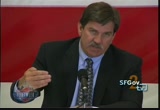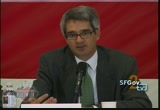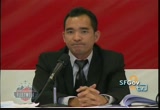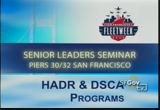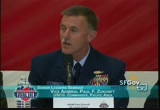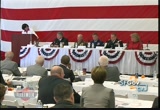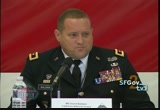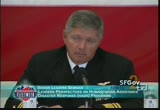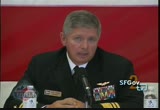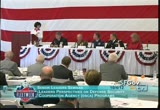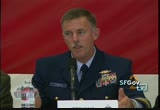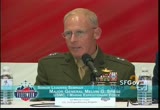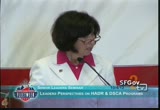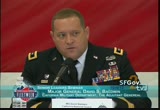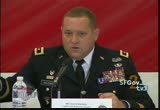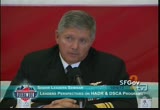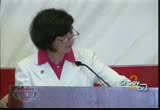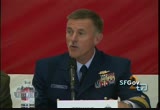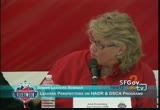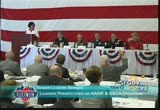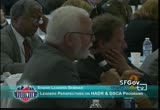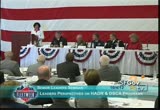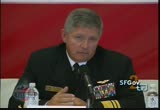tv [untitled] November 30, 2012 4:00am-4:30am PST
4:00 am
we get through that and how can we improve getting folks to the facility and making sure we know where everybody is at at all times. >> thank you. mr. boland. >> one of the major challenges that we have incurred all the way from 2003 till now, is credentialing or badging of utility emergency responder personnel trying to gain access into a secure zone that needs their services. as a prepop drapbs of the heavy equipment sometimes falls under a contractor's jurisdiction and a local officer at a local roadblock does not always know or understand the necessity to get that kind of equipment in there to restore the grid, the water system, for the telecom it is something we are still
4:01 am
struggling with and we are working with on a daily basis. >> thank you, mr. brig. >> every exercise i've been involved with, managing information and communication is easily no. 1 or 2 on the list. in the heat of an event, information is flowing in, there's usually no shortage of information rtion it's translating that to something credible that is the challenge. usually 50 percent of that information is wrong and untimely. before a unified command is established and you have various city departments or regional groups that are working together before the unified command has been established, coordinating field work in 4 counties is usually awkward. until that central message gets pushed down and all the groups are rowing together, the field, when you are dealing with the geegraphy we are dealing with in the bay area, that field coordination is always difficult in the first few hours. >> thank you. mr. angelus.
4:02 am
>> verizon wireless, every time we get involved with emergency situations we did a post meeting to analyze what we did and how we can make things better. it also pushes down to the processes and the preparedness and how we can make things better from checking our equipment to our staffing levels and it depends, really, on the situation but we always get something good out of these situations that makes our processes better. >> thank you. i'd like to thank the panel members for taking time out to discuss about lifelines. i want to point out that all of these organizations are members of the san francisco lifelines council along with many members in the audience, and rest assured we have been working with the fire chief and the police chief with pg&e and the san francisco public utilities commission to make sure we can get them to their emergencies in a timely fashion during rush hour traffic and would like to
4:03 am
4:04 am
relationship and what it means to the marines? >> sure. let me reference mayor lee from this morning. he said what we are starting to do is get beyond conversation and we're getting a feel for the impact of our training and our particular interaction. just this past year alone from the communications, command and control exercise that we did in august, yesterday bringing an air cushioned vehicle ashore on the beach, landing helicopters at lake merced and working between us and the national guard, exercising the evacuation of casualties under the control and observation of the department of emergency management, and these are things that we can only really understand through exercise, through training and then figure out where the gaps are and what we need to do to smooth those out. i'll also reference lan wilder if i can. she said something that was pretty revealing. prior to yesterday and getting
4:05 am
out on the beach and seeing us, her thinking was just to ride out the disaster. now she feels like she's in a position where she can do some strategic thinking and strategic planning, which is really an obligation for all of us in charge. as captain jones said earlier this morning, we do not know what this is going to look like and it's certainly not going to look like what we anticipate. but having us understand how to react and how to interact with each other will give us a basis upon which we can go forward and move hopefully very quickly to salvage what we can in the event of a complex catastrophe. thank you. >> and admiral zukunft, we heard a little about from captain stow about the different authorities that the coast guard can bring to bear in different situations. but could you talk a little bit about the partnerships and relationship and how that plays across the coast guard mission
4:06 am
set? >> well, first i'll talk about my capacity challenges and my area of responsibility covers the rocky mountains to madagascar. the same area of responsibility as admiral lochlear except they have the arctic and antarctic as well. so, obviously with 13,000 people covering that aor, a little over 200 ships, i'm very dependent on partnerships. i work with 71 countries with whom i have 65 bilateral agreements with those entities. but everything really starts at the most local level first. so, it's appropriate to hear from captain stow and the network of partnerships that she's dealt here in the bay area, but we have this lattice work that goes across my entire pacific region. and then i need to focus on what do i do in the event of a threat right now in dealing with the arctic. what if i have a deep water horizon spill there? because now it affects the nate and i have indigenous tribes of
4:07 am
that part of the world. and how do i flow resources there, recognizing the navy doesn't have ice breakers and our nation has one. so, we do a lot of work with canada when we're starting to work on those contingencies. but we look at the national response framework. it was rewritten post katrina. and another key part of partnerships, when i was the federal on scene coordinator during deep water horizon, it's not in the national response framework, but every parish president, every mayor, every governor had a coast guard liaison officer at the oak pride and above level. so, if they didn't like how the response was going, go to my liaison officer. don't go to anderson cooper and then cause the white house to react to what they're seeing on cnn. so, how do you get in front of that news cycle? and the only way you can do that as tip o'neill said, all things in politics are local and i think we heard from vice admiral nathan that i think all responses are local as well. and, so, we really need to
4:08 am
start most importantly at the local level, at those planning levels, because the fn, the pla change, but the partnerships need to remain constant. >> and, general baldwin, we heard from colonel span owe about now your three hats of authority, your state hat, your federal hat, and now your dual status hat. but if you could talk about the partnerships and relationships and how that plays into your ability to respond under -- wearing each one of those hats? >> sure. first i'll begin with just a little bit more background on the national guard. the national guard is unique amongst the components of the army and air force in that in addition to our war fighting mission, we have provided support to civil authorities as a core task. that's why we exist as a unique component. in addition, we're a community based force. our soldiers live and work in all the communities and already have a lot of the relationships with the first responders, the public health services, the
4:09 am
hospitals and all those entities that would respond in a disaster. the california national guard as mentioned is the largest in the nation under 54 states and territories. we're the largest by far. and we have a broad spectrum of capabilities that range from on the low end manpower where we can deploy troops for either security missions or firefighting hand crew missions all the way up to the high end where we have a wing, we also a wealth of relationship building that's key to success and any disaster response is being able
4:10 am
to work with the inter agency. we're in a unique position because in addition to my federal responsibilities for commanding both the army and the air national guard, i also serve as a member of the governor's cabinet and with that i work on a daily basis with all of the other state level assets and resources, cal ema, cal fire, the highway patrol, health and human services and all the other state entities that would respond to support local authorities. we have a full-time liaison officer embedded in cal ema that works there 7 days a week, 5 days a week to continue to develop and build that relationship. we exercise regularly at all levels of government. we exercise heavily with the local governments to plan and prepare. and we work very, very closely with defense coordinating officer as we continue to build and work our relationships with north com and the ability to integrate title 10 forces both acting in the reserve into the sole support flight. we have a strong working relationship with the coast guard and we're excited with
4:11 am
the team to develop our relationship with the third fleet and marine corps as we mature this tactical man construct. >> thank you. we know that with humanitarian assistance and disaster response that what we learn domestically can be exported internationally and what we learn internationally we hope would be imported to our domestic programs. this morning as we listened to the medical panel and to vice admiral nathan's comments, we heard about some of the skills and expertise in the medical arena that have been learned internationally and are being brought to bear through the exchange both yesterday and today to the local scene. wondering if the panel has other examples that they could cite on where the benefits have been learned that have been taken, specific skills that have been taken internationally as we look at humantarian assistance, or that you know that you'd like to bring back and bring into the domestic arena.
4:12 am
>> just this last summer, we conducted the rim of the pacific exercise 2012. we did it in the state of hawaii and the surrounding operating area. it brought forth 22 nations, roughly 25,000 soldiers, sailors, airmen, marines. but one of the things that we did embedded in this rim pac exercise was a five-day humanitarian assistance disaster relief. we used it as an accreditation not only for some of our adaptive force packages, but more importantly to the state of hawaii to allow them to get an accreditation that they needed for 13 of their hospitals where we set up on ford island, those familiar with the oahu island geography, we utilized ford island and we had a scenario where there was an earthquake with a resultant tsunami and mass casualties
4:13 am
along with the destruction that goes with it to the road infrastructure and communication. and, so, we were able to parlay, if you will, this opportunity to leverage off our international partners. we had seven nations that out of the 22 that actually participated in the hadr, and there were probably also 19 of the 22 that at least observed. but there were 7 of us that actually participated. and we were able to share with each other those things that worked, those things that don't work. it's interesting because one of the things that we work very hard on was one of the things that the first panel this morning talked about, and that was communication. and language, a common lexicon. so, it was not only a common lexicon, but then a common language that everybody understood when you bring international partners together. we hope we don't have the
4:14 am
language barrier for a domestic natural disaster, but nonetheless, there is a language each one of us carries on. we talked about the acronyms each one of us uses. so, we had a real-world -- a real-live exercise that validated some of the things we talk about this morning. but it was extremely beneficial to not only the u.s. navy and marine corps, but to the international community. >> thank you. another hand? >> [inaudible] my experience with the haiti response. in this casey i was working at the deputy principal committee level and working at the white house. but it was really the first opportunity for this administration to work with a very complex response, and then recognizing for us the supported commander was usaid that normally isn't in the emergency response business. so, it was an educational
4:15 am
process of how to move forces and yet support usaid and the role of the country team and port au prince. so, it was very informative there. and to back up when we had the first no fooling hurricane that worked its way up the entire gulf coast, the principal committee calls that were generated during the haiti response were then turned around and then bringing all of the governors into a conference call with the president to make sure that all their needs were being met in the advance of a hurricane arrival. so, we really had all of government, from local all the way up to the white house, fully included in that response. but the haiti response was certainly informative in bringing all these disparate entities together to provide unity of effort during a response. >> we need general spiese. >> okay, thanks.
4:16 am
i would offer a little bit from an institutional perspective at the tactical level in the marine corps. that's an area where we could use some improvement. our forces deployed to the western pacific certainly understand this, and they pass it on among themselves. the forces we deploy from southern california and the east coast that float into theater understand disaster assistance and humantarian response very well. that hasn't quite migrated itself into the institutional arena in terms of forces stationed here in the united states as it would relate to defense support to civil authorities. i think that's primarily -- this is not a primary mission for us. it's something that we do pay attention to, of course, as we deploy overseas. not necessarily forces we have here in the states. we do understand immediate response, rolling out the gate to help our neighbors in an immediate nature, but i think
4:17 am
not so much in terms of mobilization and deploying inside our country. so, this is an area where opportunities like san francisco fleet week will allow us for, and i believe at some point really incorporate this in some internal doctrine that will benefit us in the event that this is a requirement inside the u.s. >> thank you. this morning secretary schultz asked one of the panels that was involved in communications and command and control about in this age of information, real-time information, how you're hit with a sea of information and how do you deal with that. something as senior leaders all of you have dealt with. and i believe admiral zukunft used the term dealing with reality tv. so, until you get that unity of effort and get into an up tempo, how do you as a senior leader deal with that sea of information coming at you
4:18 am
that's all over cnn and the cable as you look at deploying your forces? >> i'll take that one again. and i'll go back to my experience during the gulf oil spill. and we lost public trust very early on because we would quote numbers and then the numbers would change and then the more they changed, and if you're the speaking head, you lose public trust. in that event we had a great wealth of scientific support that brought in to give you situational awareness. and my requirement as the on scene commander is how do i get this into the social media? and, so, in this case noaa had a product called the emergency management response application which was very nascent. i told dp, i need everything to get this live within 72 hours. they came up with $200 million and it went live. if i had to bid that through,
4:19 am
you know, through our channels, i might see it five years from today. but now we've run the slide. and on the first day that irma was in social media, we had 250,000 hits. on the second day it was over 3 million. and people could actually navigate through this tool. and what i was saying, they could validate using gps encrypted photographs where the response was. but it helped close that public trust gap and that's really where being able to move as much information as we can out into the public domain as we talk about cop. and obviously we need to look about cyber concerns as well. but certainly there is a responsibility to share, and especially with the general public because those are the ones that are going to say yea or nay in terms of how we're responding to an event. >> in the service of managing information during a disaster response, we've developed a very sophisticated common operating picture that has become to be the national standard by using both the
4:20 am
doctrine that we have in the military and in the army for the way the commander wants to see the battle field or in this case see the disaster by defining information requirements and then putting out requests for information down to our subordinate units and to our adjacent units or inter agency partners whether in law enforcement or fire or emergency management to bring in and collect all that information to a central node and our emergency center that filters the information i need to make decisions. now, our common operating picture, we developed initially based on military platforms. but we've migrate it had to a web-based solution that is open to all of our inter agency partners. it's on the dot-gov domain, it's password protected but it's not on our military proprietary systems. so, we can share the common operating picture that we have with cal ema and we've developed the ability to import data from every allied organization whether it's usgs, the law enforcement agencies, fire, weather, what have you,
4:21 am
to be able to put it out in layers so we literally can know everything going on. we can see lightning strikes that cause fires, down to the size of a car fire. we're often able to do predictive analysis that exceeds the ability of fire and other agencies and able to call them up because we can see this and we've trained our battle captains that work in our operations center to think ahead and think three moves ahead whether or not an event they see developing is going to cause a trigger that is going to require national guard or other military forces to deploy. >> if i may, i think it's for us, myself as the senior leader in third fleet, it's about information sharing and intelligence fusion and turning that into actionable knowledge. we have a 24/7 maritime operation center as well that we attempt to do that. we do have cnn up, usually turn the volume down and just look at the pictures and read the bumper sticker underneath to
4:22 am
get intel so we're not biased by what an individual reporter might be saying, but surprisingly enough, tongue in cheek, cnn is usually a very good source of information as to what's going on, especially domestically. we've had several incidents in the last couple years of real world experience. most recent was the california, the wildland firefighting that we took part. we actually initiated our first ira, immediate response assistance, for 72 hours where we called up one of our helicopter squadron in southern california to fight the fires. so, for us, again, that common operating picture, that's a recurring term that several people on different panels today have used, but that is the king for us. it's our situational awareness. it's what allows us to turn the volumes of information into those nuggets of actionable
4:23 am
knowledge that we really need in order to support those that need our assistance. >> okay. over the last eight hours, however long we've been here, we've heard quite a bit about new skill development, and learning about new capabilities, but didn't hear the word sustainment of skills mentioned, which also becomes important. would anyone on the panel care to comment on how you wrap that into the system that we are -- we've embarked on here in the exercise arena with fleet week? >> whenever you show up for a response, we have to speak a common language. and the common language is instant command system. that's a skill set that we've sustained among our entire work force because if you can't speak in a common lexicon, then
4:24 am
you're probably doomed to fail when you're in that planning sea -- developing your plans and executing your incident action plan. so, that's become a critical skill set. for every active duty, every reservist and even our coast guard auxiliaryist, 35,000 volunteers, some you may see outside the gate and say, wow, the coast guard hangs onto its people a long time. they're median age, older than me, but they volunteer their services, including during an emergency response. and they, too, are ics trained to support in a time of emergency. >> sustaining these skills is something that, as you say, jody, is a deliberate action. we're in the process of doing that right now. we have built san francisco fleet week and its associated exercises into our training continuum, and we'll continue to do so into the future. this will give us several milestones on our calendar that will get our heads back into this very complex arena. so, we certainly understand
4:25 am
that. i think we're going to be seeing guidance coming from the secretary of the defense in the next couple of years that will elevate this in terms of our responsibilities and mission sets. so, we're in the process of laying the groundwork for that right now at camp pendleton. >> ann? >> just to build on what general spiese said, fleet week, this used to be or started as a one-week event, is now really -- goes year round. and, so, the relationships we're building, it's not just for this week. you know, we're building trust. we're building -- we're building that kind of knowledge of each other's capabilities, of our competencies that we will continue to exercise throughout the yearses. so, i think that's a very important point to make, that fleet week is not just one week, but these relationships
4:26 am
are ongoing. >> and tomorrow we'll have some specific training of the military training civil authorities and civil authorities training military with specific skills that they'll be able to bring to bear in their specific area of responsibility. i'd like to open it up to the audience now to see if there might be some questions for these leaders. and then also one last question. do we have -- okay, they're getting a microphone now, jeff. thank you, admiral. the last issue that you all just talked about, the sustainability issue, this is the one that concerns me because a lot of people in local government, i'm sure, have had the same experience we have in oakland.
4:27 am
many great programs start off very well, then people leave. budgets get cut. there's no sustainability. and they go off into the horizon. so, you four enlightened commanders, you understand this. but the challenges ahead, sequestration, perhaps, your budgets, change of command, retirement -- how do you four feel about being able to sustain this program and the concept that has been started here in the last three years at san francisco fleet week? >> i'll take that, jeff. one of the things that we have done is made sure that we derive value and benefit from the programs that we participate in. if we were showing up to be a training aid for somebody else, that would certainly die out. but we have mapped out objectives for ourselves which
4:28 am
really benefit us across the spectrum of our operations. so, if you understand that going into this business and you know that you can get something out of it, there is a greater willingness, i think, to participate. so, we're in the process of building that and trying to codify that into our long-term training plan. >> if you talk to my marine brethren, they may kit indicate that the navy would leave you. [laughter] >> some of you got that. it has to do with a little i sland that -- * [laughter] >> anyway, i can assure you that the u.s. navy is not going to leave. and some of the things that i used to back that up, general ka joe bastardi i, commander in the northern command, who really has overall responsibility for a military effort with regards to domestic support to civil authorities will be here tomorrow. i think it's the first time that we've had the commander in
4:29 am
the northern command and the three such sos that we've had, he is going to adopt a model that we employed with the immediate response assistance that i indicated to you earlier that we used earlier this year. he's going to adopt that as the model for northern command with the army and the air force to use. i think the momentum that we have gained here over the last three years, we leveraged off of that. we started a similar senior leadership seminar up in seattle, that we had the first one this year. they have some people down here from the seattle sea fair, which is the equivalent of san francisco fleet week association. they have people from the sea fair committee, board, if you l that is here observing what we do here in san francisco. and, so, those are great indicators to
90 Views
IN COLLECTIONS
SFGTV2: San Francisco Government Television Television Archive
Television Archive  Television Archive News Search Service
Television Archive News Search Service 
Uploaded by TV Archive on

 Live Music Archive
Live Music Archive Librivox Free Audio
Librivox Free Audio Metropolitan Museum
Metropolitan Museum Cleveland Museum of Art
Cleveland Museum of Art Internet Arcade
Internet Arcade Console Living Room
Console Living Room Books to Borrow
Books to Borrow Open Library
Open Library TV News
TV News Understanding 9/11
Understanding 9/11